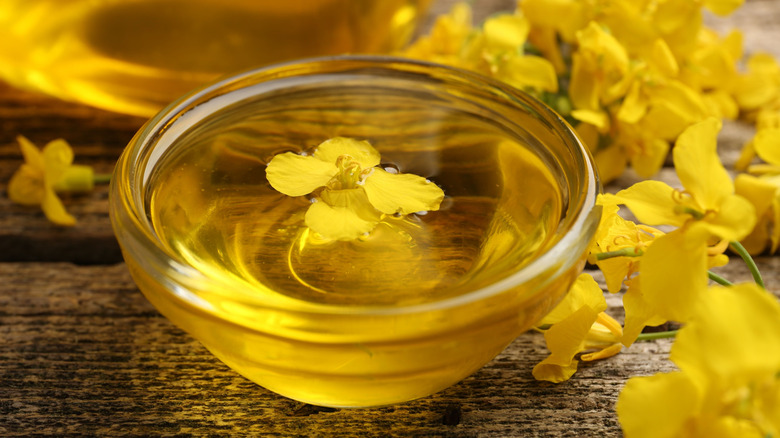Canola Oil Vs Vegetable Oil: What's The Difference & When Should You Use Each?
There are so many cooking oils to choose from that it can make your head spin. There's the commonplace olive oil, as well as the pricey avocado oil, coconut oil, which you have to use on low heat, and sesame oil, which can elevate mediocre store-bought mayo. And then there are two of the most popular cooking oils, canola oil and vegetable oil, which might seem so similar that you forget they are entirely separate entities. It's true, both have high smoke points, their coloring is alike, and they're relatively cheap, but Food Republic consulted with Joanne Gallagher, recipe creator and co-founder of Inspired Taste, and she gave us the low-down on how they're different and when each should be used.
"The main difference is in their source and flavor," she told us. And while they are mostly interchangeable, "for delicate baking recipes, like pancakes, some prefer canola because of its lighter flavor." But that's not all — let's do a deeper dive into what makes each oil different and how you should be using them in your cooking.
Canola oil: A lighter option
As Joanne Gallagher said, the biggest difference between canola oil and vegetable oil is from where they are sourced. "Canola oil is made from rapeseed," she explained. Rapeseed comes from the rape plant, which is a cousin of cauliflower and broccoli plants. It didn't even exist before the 1970s, when scientists in Canada invented it while they were attempting to breed a human-ingestible rapeseed plant — so chalk one up for science. There are now two types of rapeseed: an industrial version and canola for cooking purposes.
Gallagher called canola oil "slightly lighter and more neutral," which means in addition to working better in baked goods, it's best used in any application where you would also use vegetable oil, but you don't want any additional flavors in the mix. It's also lower in saturated fat than vegetable oil.
Vegetable oil: Multi-sourced and multipurpose
Vegetable oil is a bit of a misnomer, since it's not derived from carrots or zucchini. According to Joanne Gallagher, it's "usually a blend" of oils, typically a mix of soybean and corn, but it can also include sunflower or safflower — or it might be just one type of oil, like Walmart's Great Value brand, which is solely made up of soybean oil. If you're wondering what your vegetable oil contains, just check the label for the ingredients. While some brands do consist of only one type of oil, the ones that include a blend do not tell you how much of each is used so the nutritional profile can vary.
Gallagher also mentioned that vegetable oil can "have a slightly heavier or more processed taste" than canola oil. Still, aside from in baked goods, you likely won't be able to tell the difference, so use vegetable oil for numerous applications, including deep and shallow frying and sautéing, as well as in marinades or salad dressings.



